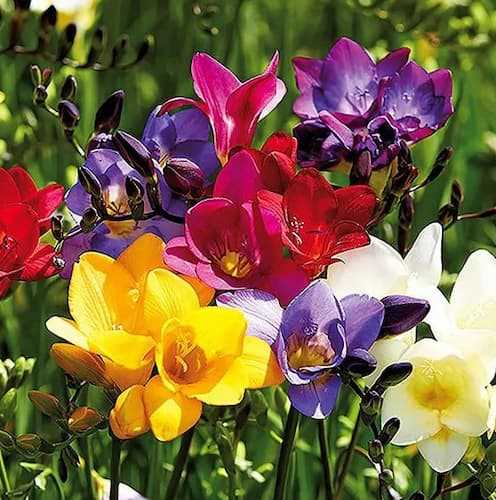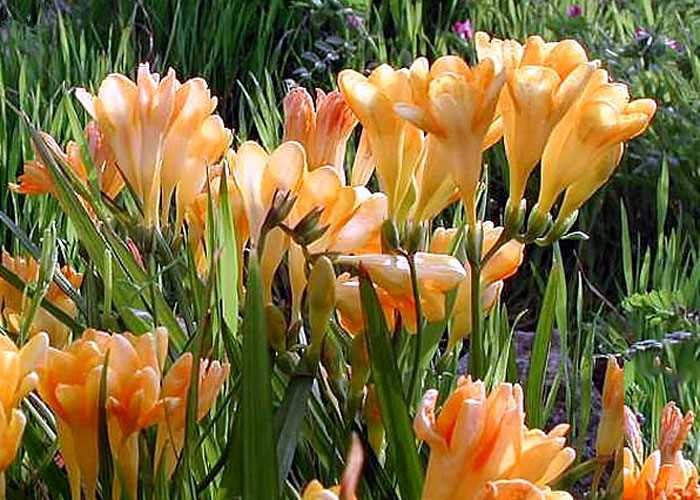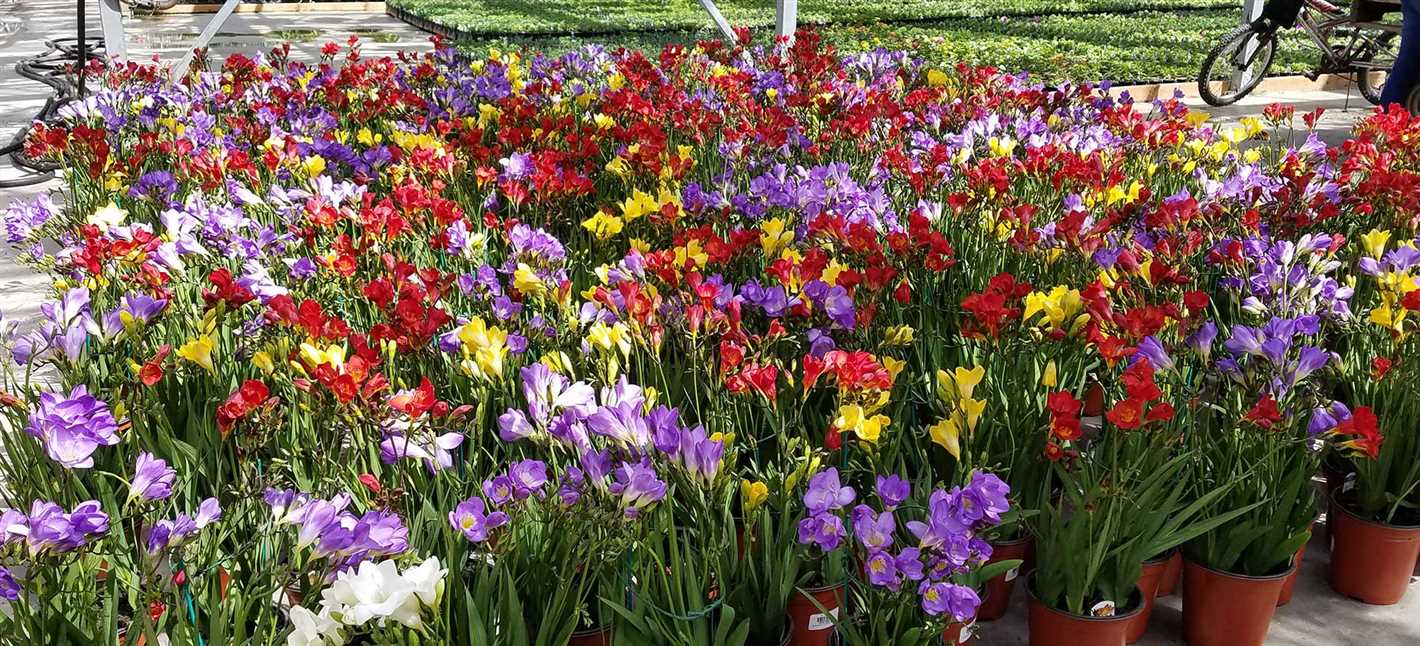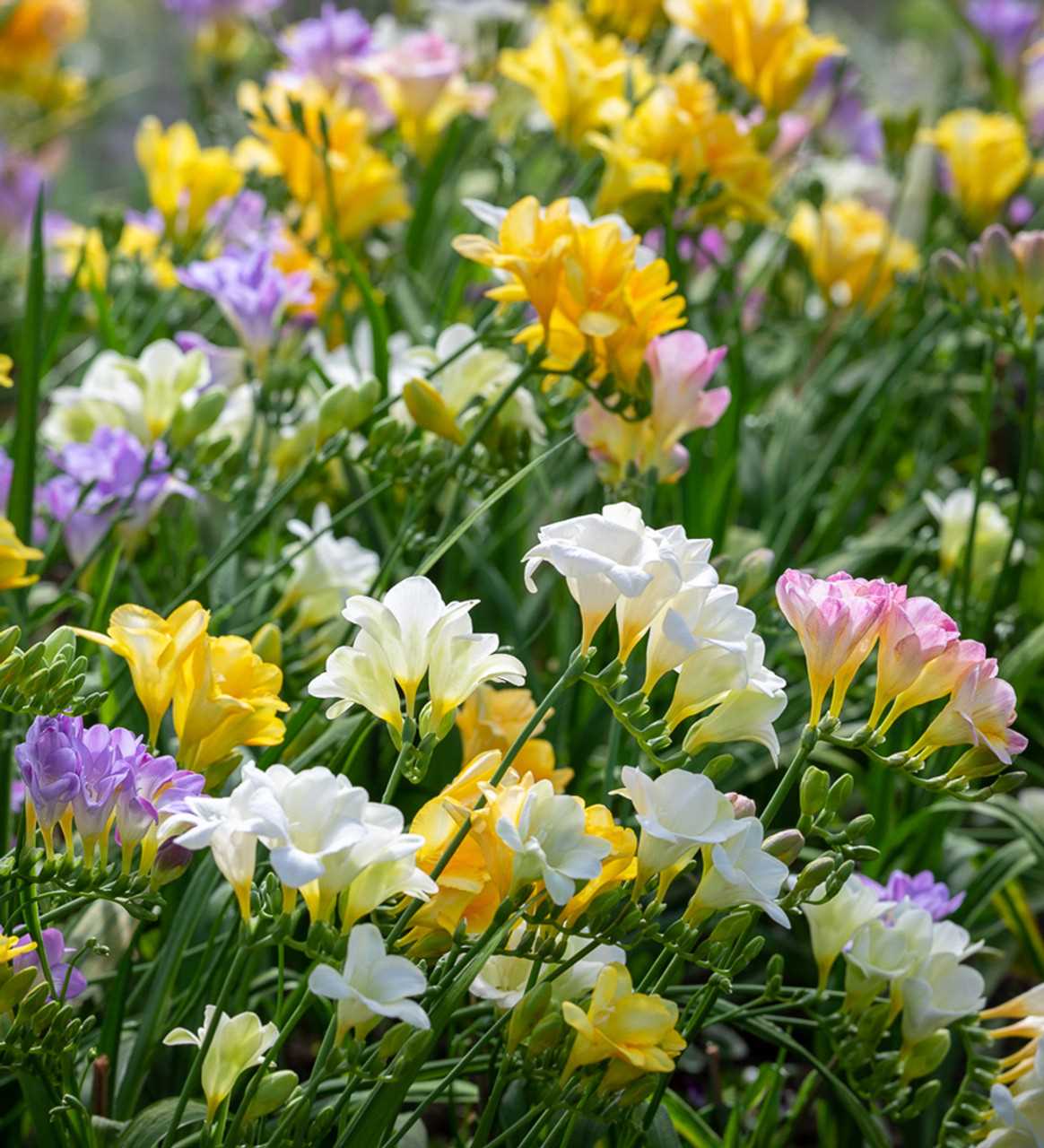- Best Soil and Location for Freesia
- Soil Requirements
- Location
- Container Growing
- Summary
- Planting Freesia Bulbs
- Choosing the Right Location
- Preparing the Soil
- Planting Process
- Watering and Care
- Support and Protection
- Additional Tips
- Watering and Fertilizing Freesia
- Watering
- Fertilizing
- Tips for Growing Freesia in Containers
- 1. Choose the right container
- 2. Use well-draining soil
- 3. Plant the bulbs correctly
- 4. Water properly
- 5. Provide adequate sunlight
- 6. Fertilize regularly
- 7. Support the plants
- 8. Deadhead and remove faded flowers
- 9. Protect from extreme temperatures
- Protecting Freesia from Pests and Diseases
- Common Pests
- Preventing Diseases
- Tips for Disease Control
- Conclusion
- Freesia Care and Maintenance
- Planting Freesia Bulbs
- Watering and Feeding
- Support and Staking
- Deadheading and Pruning
- Winter Care
- Pests and Diseases
- Conclusion
- Harvesting and Storing Freesia Bulbs
- 1. Wait for the Right Time
- 2. Digging up the Bulbs
- 3. Cleaning the Bulbs
- 4. Curing
- 5. Trimming and Sorting
- 6. Storage Containers
- 7. Storing the Bulbs
- 8. Check and Monitor
- 9. Planting Time
- FAQ:
- What kind of soil is best for growing freesia?
- How often should I water freesia plants?
- Can freesias be grown indoors?
- When is the best time to plant freesia bulbs?
- How long does it take for freesias to bloom?
- Video: How to Grow Freesia from Bulb | Fragrant Flower | Complete Season 20 with Updates
Freesias are beautiful and delicate flowers that are loved for their vibrant colors and enchanting fragrance. They are a popular choice for gardens and also make stunning cut flowers for bouquets. Whether you are an experienced gardener or a beginner, growing freesias can be a rewarding and enjoyable experience.
One of the first things to consider when growing freesias is their ideal growing conditions. Freesias thrive in sunny spots with well-draining soil. They are native to South Africa, so they are accustomed to warm and dry conditions. It is important to plant them in an area that receives at least 6 hours of sunlight a day.
When it comes to planting freesias, it’s best to wait until after the last frost in your area. They are delicate flowers and can be damaged by cold temperatures. Plant the corms (bulbs) in the ground about 2-3 inches deep and 2-3 inches apart. Water them thoroughly after planting, but be careful not to overwater as this can cause the bulbs to rot.
Freesias are known for their stunning blooms and delightful fragrance. They come in a variety of colors, including shades of white, yellow, pink, purple, and orange. To encourage blooming, it’s important to deadhead the spent flowers. This means removing the faded blooms to allow the plant to focus its energy on producing new flowers.
In addition to growing freesias in the garden, they can also be grown indoors in pots. This can be a great option if you don’t have a garden or if you want to enjoy their beauty and fragrance inside your home. When growing freesias indoors, choose a pot with good drainage and fill it with a well-draining potting mix. Place the pot in a sunny window and water regularly, keeping the soil evenly moist but not soggy.
With the right care and attention, freesias can thrive and bring joy to your garden or home. Follow these expert tips and advice to ensure beautiful blooms and an enchanting fragrance that will uplift your spirits.
Best Soil and Location for Freesia

Freesias are beautiful flowers that can add color and fragrance to any garden or home. To ensure that your freesias grow and thrive, it’s important to provide them with the right soil and location.
Soil Requirements
Freesias prefer well-draining soil that is rich in organic matter. The soil should be loose and crumbly, allowing for good air circulation and water drainage. Heavy clay or compacted soils can lead to root rot and other problems.
A pH level between 6.0 and 7.5 is ideal for freesias. You can amend the soil with organic matter, such as compost or well-rotted manure, to improve its fertility and drainage.
Location
Freesias require full sun to partial shade for optimal growth. Choose a location that receives at least 6 hours of direct sunlight per day. In hotter climates, some afternoon shade can help protect the plants from excessive heat.
When selecting a location for your freesias, also consider the wind exposure. Freesias have delicate stems and can be prone to bending or breaking in strong winds. If your garden is prone to high winds, consider planting your freesias in a more sheltered area or provide some protection, such as a windbreak or trellis.
Container Growing
If you plan to grow freesias in containers, make sure to choose a pot with good drainage holes to prevent waterlogged soil. Use a well-draining potting mix that is specifically formulated for containers.
Place the containers in a sunny location, such as a patio or balcony, where they can receive adequate sunlight. Regularly monitor the moisture level in the potting mix and water as needed, being careful not to overwater.
Summary
- Use well-draining soil rich in organic matter for freesias
- A pH level between 6.0 and 7.5 is ideal
- Select a location with full sun to partial shade
- Consider wind exposure and provide protection if necessary
- Choose a container with good drainage holes for container growing
- Use a well-draining potting mix and provide adequate sunlight
By providing your freesias with the right soil and location, you can ensure that they thrive and produce beautiful blooms year after year.
Planting Freesia Bulbs
Freesia bulbs are a popular choice for gardeners who want to add a splash of color and fragrance to their garden. These beautiful flowering bulbs are relatively easy to plant and care for, making them a great choice for both experienced and novice gardeners. Here are some expert tips for planting freesia bulbs:
Choosing the Right Location
Freesias prefer a sunny location with well-drained soil. Look for an area in your garden that receives at least 6-8 hours of direct sunlight per day. Avoid planting freesias in low-lying areas or where water tends to accumulate, as excess moisture can cause the bulbs to rot.
Preparing the Soil
Before planting, it’s important to prepare the soil properly. Freesias prefer soil that is loose, fertile, and well-drained. Start by removing any weeds or debris from the planting area. Use a garden fork or tiller to loosen the soil and incorporate organic matter, such as compost or well-rotted manure, to improve drainage and add nutrients.
Planting Process

Dig a hole that is about 4-6 inches deep and space the bulbs about 4-6 inches apart. Place the bulb in the hole with the pointed end facing up and cover it with soil. Gently firm the soil around the bulb, making sure it is securely planted. Water the bulbs thoroughly after planting to help settle the soil.
Watering and Care
Freesias need regular watering, especially during the growing season. Keep the soil evenly moist, but avoid overwatering as it can lead to bulb rot. Water at the base of the plants to prevent the foliage and flowers from getting wet, as this can increase the risk of fungal diseases. Apply a layer of mulch around the plants to help conserve moisture and suppress weed growth.
Support and Protection
As freesias grow, they may need support to keep their stems upright. Use stakes or hoops to provide support and prevent the plants from bending or breaking. Additionally, consider protecting the plants from strong winds, which can damage the delicate blooms. If your area is prone to frost, cover the freesias with a layer of straw or horticultural fleece to protect them during cold spells.
Additional Tips
- Plant freesia bulbs in the fall, before the first frost in your area.
- Consider planting freesias in containers or pots if you have limited garden space.
- Deadhead the spent flowers to encourage continuous blooming.
- Freesias can be grown as perennials in frost-free regions, or as annuals in colder climates.
| Location | Soil Preparation | Planting Process | Watering and Care |
|---|---|---|---|
| Sunny area with well-drained soil | Loose, fertile soil with organic matter | Plant bulbs 4-6 inches apart with pointed end up | Keep soil evenly moist, avoid overwatering |
| Avoid low-lying areas or waterlogged soil | Remove weeds and debris, amend soil if needed | Firm soil around bulbs, water thoroughly after planting | Water at base of plants, apply mulch |
Watering and Fertilizing Freesia
Proper watering and fertilizing are crucial for the healthy growth and blooming of freesia plants. Follow these expert tips and advice to ensure your freesias thrive:
Watering
Watering is an essential aspect of caring for freesia plants. Here are some guidelines to follow:
- Water your freesias regularly to keep the soil moist but not waterlogged. Freesias prefer a slightly damp soil but can’t tolerate standing water.
- Check the soil moisture by inserting your finger into the top inch of soil. If it feels dry, it’s time to water.
- Water deeply, allowing the water to reach the root zone. Shallow watering can lead to shallow root growth.
- Avoid overhead watering, as it can promote the development of fungal diseases. Instead, water at the base of the plant.
- During hot summer months, increase the frequency of watering to compensate for the increased evaporation rate.
Fertilizing
Applying the right fertilizer at the right time is crucial for the proper nourishment of freesia plants. Here’s what you need to know:
- Before planting freesia bulbs, mix a balanced slow-release fertilizer into the soil to provide nutrients throughout the growing season.
- Alternatively, you can use a liquid fertilizer diluted according to the instructions on the package. Apply it every two weeks during the growing season.
- During the blooming period, switch to a fertilizer with a higher phosphorus content to promote healthy flower development.
- Avoid over-fertilizing, as it can lead to excessive foliage growth at the expense of flower production.
- Water the plants after fertilizing to ensure the nutrients are absorbed by the roots.
By following these watering and fertilizing guidelines, you can enjoy vibrant and healthy freesia plants in your garden or home.
Tips for Growing Freesia in Containers
Growing freesia in containers is a great way to enjoy these beautiful flowers in small spaces or for those without a garden. Here are some expert tips to help you successfully grow freesia in containers:
1. Choose the right container
For growing freesia, select a container that is at least 6-8 inches deep to accommodate the bulbs. Make sure the container has drainage holes to prevent waterlogging.
2. Use well-draining soil
Freesias prefer well-draining soil to avoid rotting. Use a potting mix that contains a combination of perlite, vermiculite, and peat moss to ensure good drainage.
3. Plant the bulbs correctly
Plant the freesia bulbs with the pointed end facing up. Place the bulbs 2-3 inches apart in the container. Cover the bulbs with soil, leaving the top third of the bulb exposed.
4. Water properly
Freesias need regular watering to keep the soil moist but not waterlogged. Water the container when the top inch of soil feels dry. Avoid overhead watering as it can cause the flowers and foliage to rot.
5. Provide adequate sunlight
Place the container in a sunny location where the freesias will receive at least 6 hours of direct sunlight each day. Freesias thrive in full sun but can tolerate partial shade.
6. Fertilize regularly
Feed the freesias with a balanced liquid fertilizer once a month during the growing season. This will provide the necessary nutrients for healthy growth and abundant flowering.
7. Support the plants
Freesia stems can be floppy, especially when in bloom. Use stakes or small supports to keep the plants upright and prevent them from falling over.
8. Deadhead and remove faded flowers
To prolong the blooming period, regularly deadhead the faded flowers. This will encourage the plants to produce more blooms and keep the container looking tidy.
9. Protect from extreme temperatures
Freesias are susceptible to extreme cold and heat. If temperatures drop below freezing or rise above 90°F, bring the container indoors or move it to a sheltered spot to protect the plants.
Following these tips will help you successfully grow freesia in containers and enjoy their colorful blooms throughout the season. Happy gardening!
Protecting Freesia from Pests and Diseases
Freesias are generally hardy plants, but like any other plants, they can be vulnerable to certain pests and diseases. Taking proactive measures to prevent and control these issues will help you maintain healthy freesias in your garden or at home.
Common Pests
- Aphids: These small insects suck the sap from leaves and stems, causing them to distort or curl. Regularly inspect your freesias for aphids and if found, control them using insecticidal soap or neem oil.
- Snails and Slugs: These slimy creatures can chew through leaves and flowers. To keep them at bay, create physical barriers using copper tape or apply organic snail and slug control methods like beer traps or eggshell barriers.
Preventing Diseases
Fungal Diseases: Freesias are prone to various fungal diseases, such as Botrytis blight and fusarium wilt. To prevent fungal infections, provide good air circulation by spacing the plants properly, avoiding overhead watering, and maintaining clean garden beds.
Viral Infections: Viruses can also affect freesias, causing stunted growth, yellowing leaves, and flower discoloration. Unfortunately, there are no treatments for viral infections, so the best approach is to prevent them by practicing good hygiene, such as sterilizing tools and avoiding contact with infected plants.
Tips for Disease Control
- Remove and destroy any infected plant material or debris to prevent the spread of diseases.
- Water freesias at the base to avoid wetting the foliage which can promote fungal growth.
- Regularly inspect plants for signs of pests or diseases and take prompt action if any issues are detected.
- Consider using organic pest control methods to minimize the impact on the environment.
Conclusion
By taking preventive measures and maintaining good gardening practices, you can protect your freesias from common pests and diseases. Regular inspection, prompt action, and proper care will ensure that your freesias thrive and provide you with beautiful blooms.
Freesia Care and Maintenance
Proper care and maintenance are essential for the successful growth of freesias. Here are some expert tips and advice to help you ensure your freesias thrive:
Planting Freesia Bulbs
When planting freesia bulbs, make sure to choose a well-draining soil mix. The bulbs should be planted in the fall, about 2 inches deep and spaced 3 to 4 inches apart. Freesias prefer full sun or light shade, so choose a location that receives at least 6 hours of sunlight per day.
Watering and Feeding
Keep the soil evenly moist but not wet during the growing season. Freesias require regular watering, especially during hot and dry periods. However, make sure not to overwater, as excessive moisture can lead to bulb and root rot. Applying a balanced bulb fertilizer once a month will help promote healthy growth and abundant flowering.
Support and Staking
Freesias have fragile stems that can easily bend or break. To prevent this, it is recommended to provide support and staking. Use bamboo stakes or other plant supports to keep the stems upright. Gently tie the stems to the stakes using soft string or plant ties.
Deadheading and Pruning
Remove faded or dead flowers regularly to promote continuous blooming. This practice is known as deadheading. Additionally, snip off any yellow or withered leaves to maintain the plant’s appearance and prevent the spread of diseases.
Winter Care
In regions with cold winters, freesias may not survive outdoors. To protect the bulbs from freezing temperatures, dig them up before the first frost. Allow the bulbs to dry for a few days, then store them in a cool, dry place until the following spring. You can replant the bulbs once the danger of frost has passed.
Pests and Diseases
Freesias are relatively resistant to pests and diseases. However, they can occasionally be attacked by aphids, spider mites, or bulb mites. To control these pests, regularly inspect your plants and remove any infested leaves or flowers. If the infestation persists, you can use organic insecticides or seek professional advice.
Conclusion
By following these care and maintenance tips, you can enjoy the beauty and fragrance of freesias in your garden or home. Remember to provide proper watering, feeding, and support for your plants, and they will reward you with stunning blooms. Happy gardening!
Harvesting and Storing Freesia Bulbs
Once the freesia flowers have faded and the leaves have turned yellow, it’s time to harvest the bulbs. Harvesting freesia bulbs is an important step in ensuring their survival and future growth. Here are some expert tips on how to harvest and store freesia bulbs:
1. Wait for the Right Time

It’s important to wait until the freesia plant has finished blooming and the foliage starts to die back naturally. This usually occurs in late summer or early fall.
2. Digging up the Bulbs
Use a garden fork or shovel to carefully dig up the freesia bulbs from the ground. Be careful not to damage the bulbs in the process.
3. Cleaning the Bulbs
After digging up the bulbs, gently shake off any excess soil and remove any dead foliage or roots. It’s important to clean the bulbs to prevent the spread of diseases.
4. Curing
Place the bulbs in a well-ventilated area to dry and cure for about two weeks. This helps the bulbs develop a protective layer and promotes better storage.
5. Trimming and Sorting
Once cured, trim any excess foliage or roots from the bulbs. Sort the bulbs by size and discard any damaged or diseased ones.
6. Storage Containers
Choose storage containers that are well-ventilated and provide good airflow. Paper bags or mesh bags work well for storing freesia bulbs.
7. Storing the Bulbs
Store the bulbs in a cool, dry, and dark place. Basements or garages are ideal storage locations. Be sure to label the containers with the variety and the date of harvesting to keep track of their freshness.
8. Check and Monitor

Periodically check the stored bulbs for any signs of mold, rot, or drying out. Remove any affected bulbs to prevent the spread of diseases.
9. Planting Time
Freesia bulbs can be replanted in the garden in late winter or early spring, depending on your climate. Be sure to provide them with well-drained soil and plenty of sun.
By following these expert tips, you can successfully harvest and store freesia bulbs, ensuring their health and vitality for future growth and blooming.
FAQ:
What kind of soil is best for growing freesia?
Freesias prefer well-drained, sandy soil that is rich in organic matter. A soil pH between 6 and 7 is ideal for their growth.
How often should I water freesia plants?
Freesia plants should be watered regularly during their active growing period, especially during dry spells. However, it’s important not to overwater them, as they can rot if the soil becomes too wet.
Can freesias be grown indoors?
Yes, freesias can be grown indoors in containers. They require bright light and well-drained soil. It’s important to provide them with proper ventilation and avoid overwatering.
When is the best time to plant freesia bulbs?
The best time to plant freesia bulbs is in the spring, after the danger of frost has passed. They can also be planted in the fall in areas with mild winters.
How long does it take for freesias to bloom?
Freesias typically bloom around 12 to 14 weeks after planting. However, the exact timing may vary depending on the variety and growing conditions.







